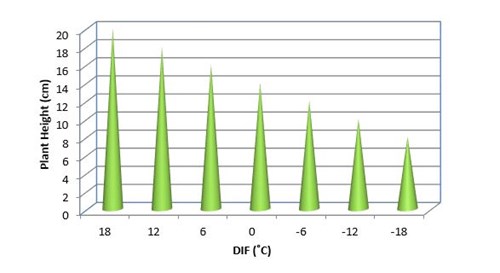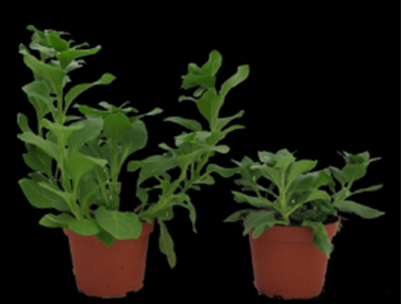DIF For Control of Plant Stretching on Bedding Plants, Ornementals and Transplants


Having a high-tech greenhouse gives the grower total control over environmental parameters including temperature, light, relative humidity and CO2 and also the root zone environment.
These environmental parameters can be manipulated to provide the optimum conditions for a crop to produce the best quality plants with high yields. In this article, we will be focusing on DIF and how it can be used to minimize plant stretching. Using DIF will increase production costs due to extra evening heating; therefore, the cost vs. benefit of using DIF has to be studied so profit is not sacrificed to produce the best quality plants.
The concept and term DIF was developed by Dr. Royal Heins and colleagues at Michigan State University in the eighties. DIF is simply the difference between day and night average temperatures and is expressed as follows:
- Positive DIF (+DIF), when the day temperature (DT) is higher than the night temperature (NT);
- Zero DIF, when the DT and the NT are the same;
- Negative DIF (-DIF), when the DT is lower than the NT.
Erwin et al. (1991), conducted experiments with Fuchsia using different DIF and photoperiod combinations. They found that stem internode length and the leaf area increased linearly as DIF increased from -15 to +15˚C. Moreover, they found that the response to +DIF was more significant on short days than on long days. The following tables show plant responses to DIF.
| African daisy | Coleus | Impatiens | Snap bean |
| Ageratum | Cauliflower | Italian bellflower | Snapdragon |
| Aster | Cosmos | Kalanchoe | Streptocarpus |
| Astilbe | Croton | Morning glory | Sweet corn |
| Basil | Cucumber | Oriental lilies | Sword fern |
| Begonia | Dalia | Pansy | Tomato |
| Brussels sprouts | Easter lily | Polka dot plant | Watermelon |
| Cabbage | Eggplant | Poinsettia | Wheat |
| Cantaloupe | Fuchsia | Portulaca | White potato |
| Celosia | Geranium | Rose | |
| Chrysanthemum | Hypoestes | Salvia |
| Aster | Hyacinth | Platycodon | Tulip |
| French marigold | Narcissus | Squash |
It is well-studied that plants exposed to +DIF tend to stretch while plants exposed to –DIF are compact. Both groups of plants will maintain the same development rate and days to flower as long as they are grown under similar average daily temperatures. However, if two sets of plants are exposed to identical DIF, let’s say -10˚C and one set of plants is grown at DT=15˚C and NT=25˚C and the other set is grown at DT=10˚C and NT=20˚C, the first set is going to have faster growth and development, due to a higher average daily temperature, than the second set. Figure 1 shows the general effect of DIF on the plant height.


Considerations when using –DIF
Plant response to DIF varies depending on the species and cultivar. Using DIF can be impractical for certain bedding plants in which the time to flowering is increased. Therefore, it is necessary to study plant behavior before DIF is applied to prevent stretching. Plants can respond to -DIF within 24-48 hours and it should be used when vegetative growth is highly active and rapid stem elongation is occurring. The length of the photoperiod has a significant influence on the effectiveness of DIF (Erwin and Heins, 1995). This is important to note because DIF will work differently in the northeast than in the southwest.
Side Effects of -DIF
There are some side effects from the use of -DIF. These include reduced leaf area, change of leaf orientation (plants exposed to +DIF tend to have upright leaf growth while plants exposed to –DIF tend to have horizontal leaf growth), shoot orientation, reduced chlorophyll content, leaf nutrient composition, lateral branching and carbon partitioning.
Cool Morning Pulse
There is another method to inhibit stem stretching based on DT and NT; the “cool morning pulse”. It has the same outcome as using -DIF. This method consists of lowering the morning temperature 3-6˚C (5-10˚F) for 2 to 3 hours at dawn. This is the time of day when stem growth is most active.
Other Considerations to Minimize Stretching
Minimizing stretching is one quality characteristic which has to be managed. Stem stretching causes plants to fall, water has to travel further to get to the top of the plant, stems become soft and plants are difficult to handle and transport. Besides DIF and cool morning pulse techniques, stem stretching can be inhibited by:
- Choosing compact plant cultivars for early spring production
- Avoid sowing or planting early in the spring season
- Eliminate shading from overhead plants, dirty covering/glazing and shadows from equipment
- Increase light levels
- Limit the amount of phosphorous supplied to plants
- Induce minor water stress on transplants; add water before they start to wilt
- Create mechanical stress by shaking or touching plants
- Increase air circulation
- Space plants properly (when plants are grown close together they tend to grow taller to catch more light)
- Expose transplants to cooler, outside conditions before transplant (harden off)
- Have a high ratio of Red: Far Red light
- Cut back or pinch plants
- Use plant growth regulators
References:
- Erwin, J. E., and R. D. Heins. 1995 "Thermomorphogenic responses in stem and leaf development." HortScience. 30(5) August 1995
- Erwin, J. E.; R. D. Heins and R. Moe. 1991 "Temperature and Photoperiod Effects on Fuchsia x hybrida Morphology." Journal of the American Society for Horticultural Science. 116(6):955-960